Chest training can be done at home with exercises such as diamond push-ups, incline or decline, plank with touch on the shoulders or bench press, which can be done with your body weight or even with the use of dumbbells or PET bottles.
Chest training can be done in 3 to 4 sets, with 8 to 15 repetitions each and with breaks of 30 to 60 seconds between each repetition for rest. However, as with any other chest workout, the type of exercise and repetitions should always be adapted to each person’s ability.
Furthermore, it is important to do mobility exercises, such as pointer, shoulder mobility and trunk rotation, before exercising, to increase joint range, improve physical performance and avoid injuries. Learn how to do mobility exercises.
9 exercises to do at home
The main exercises to include in your chest workout at home are:
1. Diamond push-up
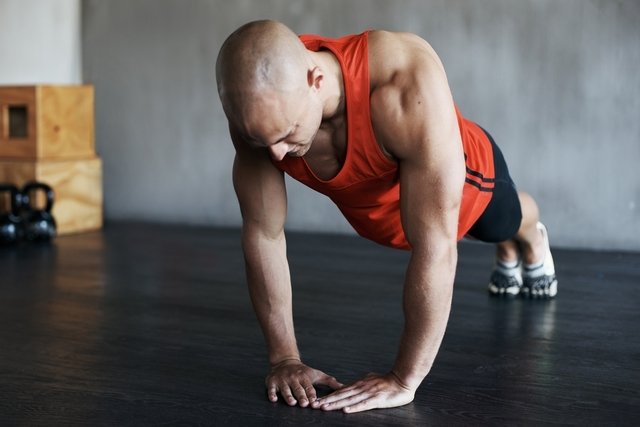
The diamond push-up, or triangle push-up, is a chest training exercise that strengthens the pectoralis major muscles, in addition to also exercising the shoulder, back and triceps muscles. Discover all the benefits of diamond flexion.
How to make: stand in a high plank position, with your feet together and your legs straight. Stretch your arms and position your hands just below and at chest height, letting your thumbs and index fingers touch each other, forming a triangle.
Contract your abdomen, exhale and bend your elbows, leaving them as close to your torso as possible and lowering your body towards the floor. Inhale and lift your body, pushing off the floor and stretching your elbows. You can do 8 to 15 repetitions of this exercise, in 3 to 4 sets and with a rest interval of between 30 and 60 seconds between each set.
2. Incline push-up
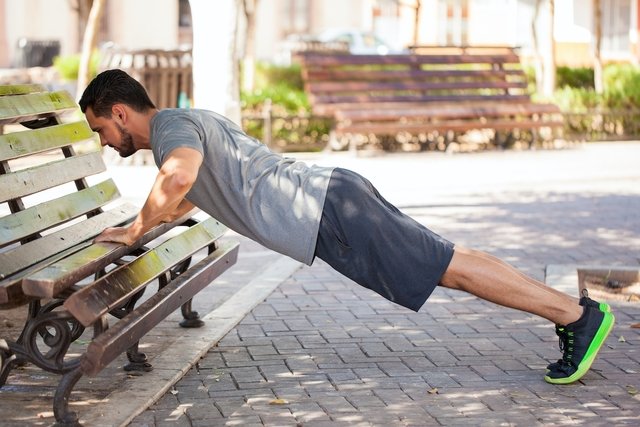
The inclined push-up helps to work a little more on the lower part of the pectoral muscle, being an easier exercise than the traditional push-up, as it uses the help of a bench or chair to relieve the weight of the body on the arms. This exercise is a great type of push-up for beginners.
How to make: place both hands on a bench or chair and stretch your legs, keeping your body straight. Then, move your chest towards the bench or chair, until your elbows are at a 90º angle. Do 8 to 15 repetitions, with 3 to 4 sets.
3. Decline push-up
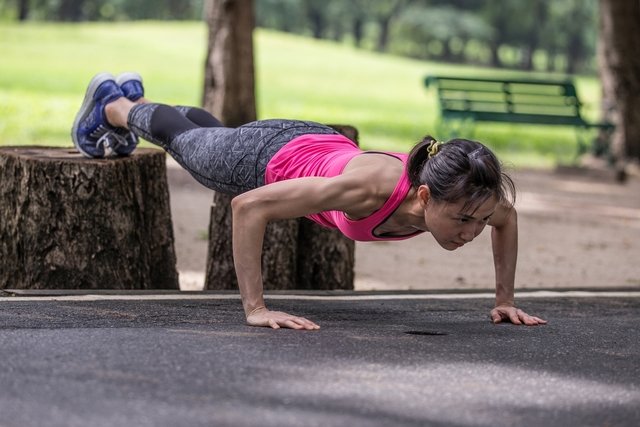
The decline push-up can help you focus a little more on the upper region of the pectoral muscle, making it a great exercise to include in your chest workout at home.
How to make: place both feet on the chair or bench and positioned shoulder-width apart. Contract your abs and glutes, and lower your chest and head towards the floor, bending your elbows. Then push off the floor, stretching your elbows and returning to the starting position.
You can do 3 to 4 sets, with 5 to 15 repetitions each. During the exercise, you must maintain your posture, avoiding letting your back bend or arch or your hips sag.
4. Isometric push-up
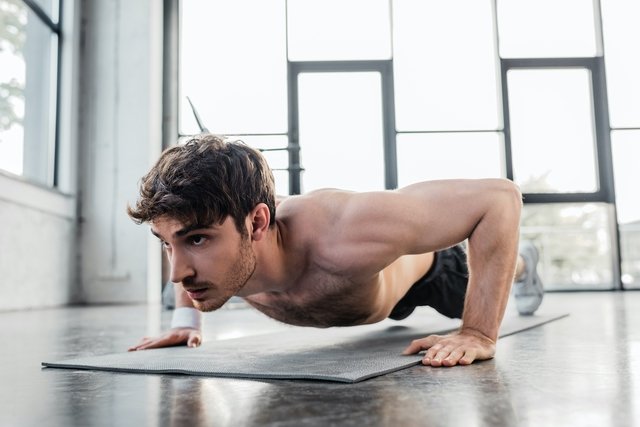
The isometric push-up is a variation of the normal push-up that allows you to increase the time under tension in the pectoral muscle, which favors muscle growth.
How to make: perform a normal push-up, but when lowering your chest to the floor with your elbows at a 90º angle, you must hold this position for 15 seconds. At all times, it is also important to keep your abdomen contracted, to keep your body aligned.
It is recommended to do 3 to 4 repetitions of this exercise, with 45 to 60 seconds of rest. In case of difficulties, you can do this push-up with your knees on the floor, for example.
5. Supine challenge
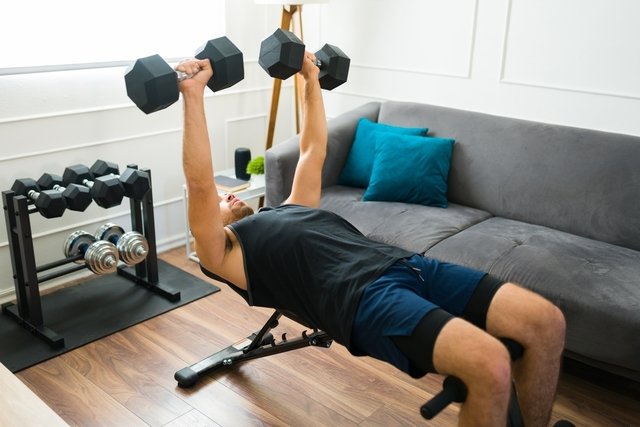
The bench press is an exercise that can be included in chest training, as it strengthens and defines the pectoral muscles, in addition to the deltoid, biceps and triceps brachii. The bench press can be done at home with dumbbells or a PET bottle.
How to make: lie face up on the floor or on a flat bench, with your feet firmly on the floor and your spine straight and neutral. Hold a dumbbell or PET bottle in each hand, with your palms facing forward.
Inhale and slowly lower the dumbbells, or PET bottles, towards the middle of your chest, keeping your elbows aligned and away from the body. Pause briefly, exhale and gently press upwards until the elbow is fully extended. You can do 2 to 4 sets, with 8 to 15 repetitions each.
6. Normal push-up
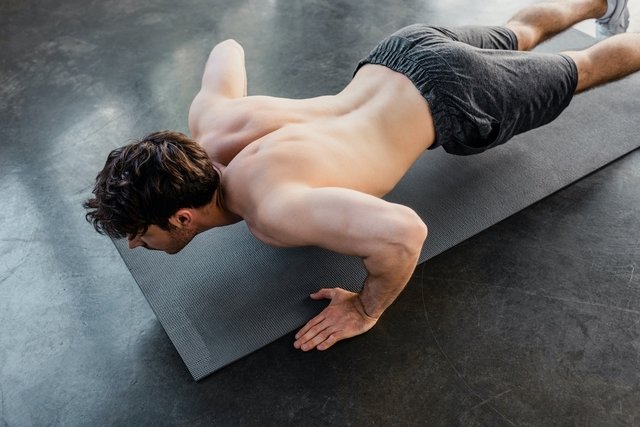
The normal or traditional push-up is a good exercise for chest training at home, as it activates several regions of the chest effectively. Additionally, normal push-ups also strengthen your shoulder and triceps muscles.
How to make: place both hands on the floor at the same width as your shoulders and then stretch your legs until they form a straight line from your shoulders to your feet. Bend your elbows and slowly lower yourself until your chest is close to the floor. Raise your body, exerting force with your arms, until you return to the starting position. You can do 3 to 4 sets, with 8 to 15 repetitions each, resting for 30 to 60 seconds between each repetition.
It is important to keep your abdomen contracted throughout the exercise to ensure that your back is always well aligned. People who find it more difficult to do the push-up with their legs straight can place their knees on the floor to lighten the load of the exercise a little.
7. Shoulder touch plank

The shoulder plank is a good exercise to do when training your chest, because, in addition to working your chest muscles, it also strengthens your abdomen, biceps and triceps. See how to do other plank exercises.
How to make: stand in the high plank position, with your legs stretched out, hip-width apart and your arms stretched out and positioned shoulder-width apart. With your head, shoulders, hips and knees aligned, raise one hand and touch the opposite shoulder. Repeat 10 to 20 times on each side, doing 3 to 4 sets and resting between 30 and 45 seconds between sets.
It is important to keep your abdomen contracted, your feet flat on the floor and avoid moving your hips to the sides throughout the exercise.
8. Isolated push-up

Isolated flexion works the muscle on each side of the pectoral, causing greater tension on the muscle and thus promoting hypertrophy.
How to make: place one hand close to the body and the other further away, so that the arm is completely stretched. Stretch your legs wide and perform the movement of lowering your chest to the floor, but applying force only on the side of your chest that has the hand closest to the body.
This exercise can be done with 10 repetitions on each side. Another easier option is to do the push-up with your knees resting on the floor.
9. Explosive push-up
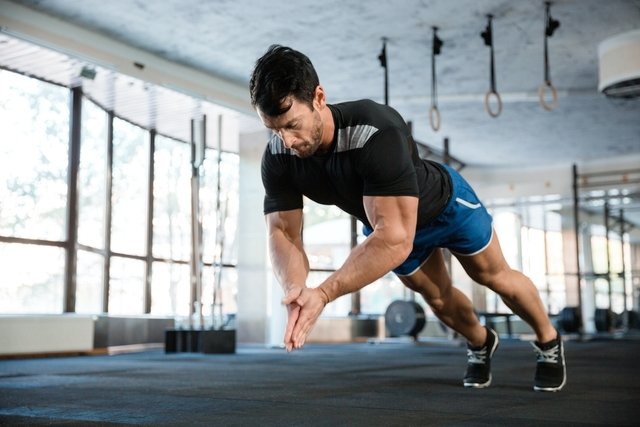
Explosive push-up, or plyometrics, is an excellent exercise for chest training, as it activates the entire pectoral muscle and uses all the contraction force.
How to make: stand in the push-up position, with the body in a straight line, feet shoulder-width apart and hips-width apart and hands shoulder-width apart. Quickly lower your chest towards the floor, bending your elbows.
When returning to the starting position, you must exert maximum force with your hands against the floor, to push your body upwards and create a slight jump and clap your hands. Land on the floor gently and continue the exercise. You can do 8 to 15 repetitions, in 3 to 4 sets, keeping a break of 45 to 60 seconds between sets.

Sign up for our newsletter and stay up to date with exclusive news
that can transform your routine!
Warning: Undefined array key "title" in /home/storelat/public_html/wp-content/plugins/link-whisper-premium/templates/frontend/related-posts.php on line 12
Warning: Undefined array key "title_tag" in /home/storelat/public_html/wp-content/plugins/link-whisper-premium/templates/frontend/related-posts.php on line 13



